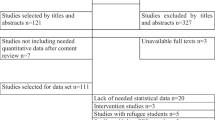Abstract
This paper explores the changes in value added (VA) of a sample of schools for cohorts of students finishing secondary education between 2005 and 2008. VA estimates are based on distance measures obtained from DEA models. These measures are computed for each pupil in each school, and evaluate the distance between the school frontier in a given year and a pooled frontier comprising all schools analysed. The school VA is then computed by aggregating the VA scores for the cohort of pupils attending that school in a given year. The ratio between VA estimates for two consecutive cohorts, that attended the school in different years, is taken as the index of VA change. However, the evolution of school performance over time should consider not only the movements of the school frontier, but should also take into account other effects, such as the proximity of the students to the best-practices, represented by the school frontier, observed over time. For that purpose we developed an enhanced Malmquist index to evaluate the evolution of school performance over time. One of the components of the Malmquist index proposed measures VA change, and the other measures the ability of all school students to move closer to their own school best practices over time. The approach developed is applied to a sample of Portuguese secondary schools.



Similar content being viewed by others
References
Andersen P, Petersen N (1993) A procedure for ranking efficient units in data envelopment analysis. Manag Sci 39(10):1261–1264
Ballou D, Sanders W, Wright P (2004) Controlling for student background in value-added assessment of teachers. J Educ Behav Stat 29(1):37–65
Banker R, Das S, Datar S (1989) Analysis of cost variances for management control in hospitals. Res Gov Nonprofit Acc 5:268–291
Berg SA, Frsund FR, Hjalmarsson L, Suominen M (1993) Banking efficiency in the nordic countries. J Bank Financ 17:371–388
Camanho AS, Dyson RG (2006) Data envelopment analysis and malmquist indices for measuring group performance. J Prod Anal 26:23–49
Cherchye L, De Witte K, Ooghe E, Nicaise I (2010) Efficiency and equity in private and public education: a nonparametric comparison. Eur J Oper Res 202(2):563–573
Coleman JS, Campbell E, Hobson C, McPartland J, Mood A, Weinfield F, York R (1966) Equality of educational opportunity. US Government Printing Office, Washington, DC
De Witte K, Thanassoulis E, Simpson G, Battisti G, Charlesworth-May A (2010) Assessing pupil and school performance by non-parametric and parametric techniques. J Oper Res Soc 61:1224–1237
Färe R, Grosskopf S, Lindgren B, Roos P (1994) Productivity developments in swedish hospitals: a Malmquist output index approach. In: Charnes A, Cooper WW, Lewin A, Seiford L (eds) Data envelopment analysis: theory, methodology and applications, Kluwer, Boston, pp 253–272
Ferrão M (2009) Sensivity of value added model specifications: measuring socio-economic status. Revista de Educacin 348:137–152
Ferrão M, Goldstein H (2009) Adjusting for measurement error in the value added model: evidence from Portugal. Qual Quant 43:951–963
Goldstein H, Rasbash J, M Y, G W (1993) A multilevel analysis of school examination results. Oxf Rev Educ 19:425–433
Gray J, Goldstein H, Jesson D (1996) Changes and improvements in school’s effectiveness: trends over five years. Res Pap Educ 11(1):35–51
Gray J, Jesson D, Sime N (1990) Estimating differences in the examination performances of secondary schools in six LEAs: a multi-level approach to school effectiveness. Oxf Rev Educ 16(2):137–157
Grosskopf S, Hayes KJ, Taylor LL, Weber WL (1999) Anticipating the consequences of school reform: a new use of DEA. Manag Sci 45(4):608–620
Hanushek E (1979) Conceptual and empirical issues in the estimation of educational production functions. J Hum Resour 14(3):351–388
Hanushek E, Taylor L (1990) Alternative assessments of performanc of schools: measurement of state variation in achievement. J Hum Resour 25(2):179–201
Kirjavainen T, Loikkanen HA (1998) Efficiency differences of Finnish senior secondary schools: an application of DEA and Tobit analysis. Econ Educ Rev 17(4):377–394
Ladd HF, Walsh RP (2002) Implementing value-added measures of school effectiveness: getting the incentives right. Econ Educ Rev 21(1):1–17
Mancebón M, Bandrés E (1999) Efficiency evaluation in secondary schools: the key role of model specification and of ex post analysis of results. Educ Econ 7(2):131–152
Mancebón M, Molinero CM (2000) Performance in primary schools. J Oper Res Soc 51(7):843–854
Mayston D (2003) Measuring and managing educational performance. J Oper Res Soc 54:679–691
O’Donoghue C, Thomas S, Goldstein H, Knight T (1997) 1996 DfEE study of value added for 16–18 year olds in England. DfEE Research Series, March
OECD: (2008) Measuring improvements in learning outcomes: best practices to assess the value-added of schools. OECD Publishing, Paris
Pastor J, Lovell C (2005) A global malmquist productivity index. Econ Lett 88:266–271
Portela M, Camanho A (2007) Performance assessment of portugese secondary schools. Working paper, Universidade Catolica Portuguesa
Portela M, Camanho A (2010) Analysis of complementary methodologies for the estimation of school value-added. J Oper Res Soc 61:1122–1132
Portela M, Thanassoulis E (2010) Malmquist-type indexes in the presence of negative data: an application to bank branches. J Bank Financ 34:1472–1483
Portela M, Thanassoulis E, Horncastle A, Maugg T (2011) Productivity change in the water industry in england and wales: application of the meta-malmquist index. J Oper Res Soc (in press)
Portela MCAS, Thanassoulis E (2001) Decomposing school and school type efficiency. Eur J Oper Res 132(2):114–130
Raudenbush SW, Bryk AS (2002) Hierarchical linear models, 2nd edn. Sage Publications, Thousand Oaks, CA
Raudenbush S, Willms JD (1995) The estimation of school effects. J Educ Behav Stat 20(4):307–335
Acknowledgments
The authors thank Fundação Manuel Leão, in particular professor Joaquim Azevedo, for allowing the use of the AVES data in this study. The authors also acknowledge the financial support of the Portuguese Foundation for Science and Technology (FCT) through project PTDC/GES/68213/2006.
Author information
Authors and Affiliations
Corresponding author
Rights and permissions
About this article
Cite this article
Portela, M.C., Camanho, A.S. & Keshvari, A. Assessing the evolution of school performance and value-added: trends over four years. J Prod Anal 39, 1–14 (2013). https://doi.org/10.1007/s11123-012-0263-5
Published:
Issue Date:
DOI: https://doi.org/10.1007/s11123-012-0263-5




